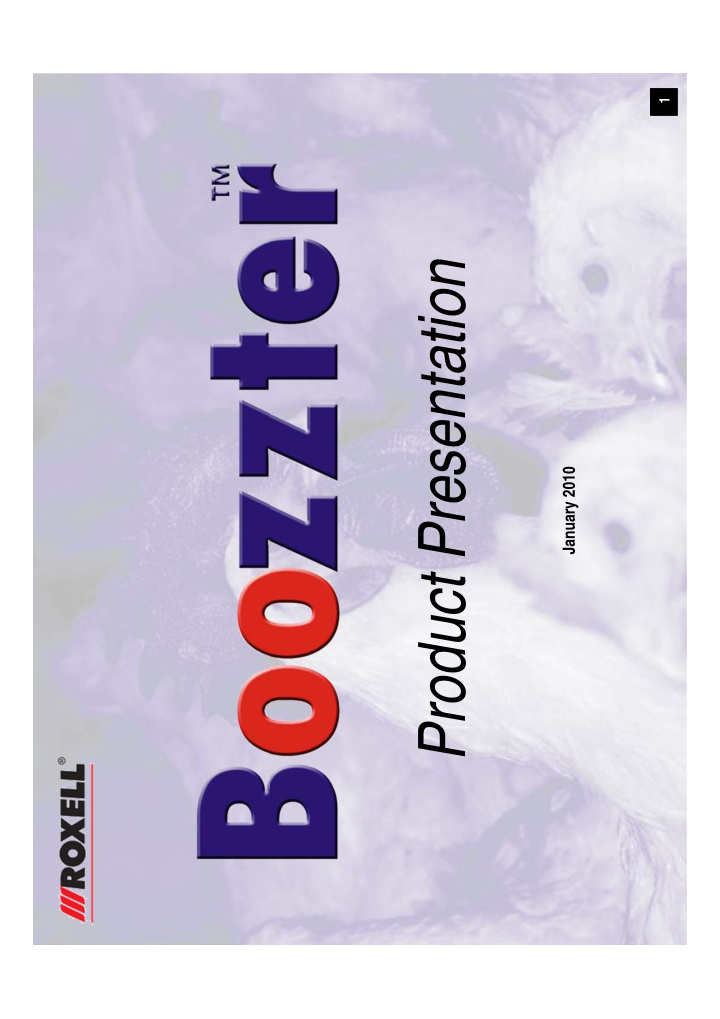



1 1 Product Presentation January 2010
1 Fast feed distribution Aim: 2 Comfortable, bird friendly Highest nr. of 3 Maximum feed savings high quality chicks at 4 Easy management lowest cost! 5 High durability 2 2
Fast feed distribution All cockerels receive feed at the same time High feed transport 700 kg/hour 3 3
4 4 = = Fast feed distribution Indexed tube
Fast feed distribution Unique pan design Small amount of feed in each pan 5 5
Comfortable, bird friendly • 10 feeding places • Easy to reach 10 comfortable places 10 wide openings 6 6
Comfortable, bird friendly • No sharp edges • Enough space for the comb No injuries! 7 7
Maximum feed savings Stepped pan + 10 individual places 10 9 1 8 2 7 3 6 4 5 8 8
Easy Management Anti swing clamp Pinch bracket Stable pan Stable line • The pan and line stay in position. • Greedy birds do not push the pan away Equal changes for every bird Better management because of individual feed distribution 9 9
Easy Management Adjuster ring • To determine the level of feed in the pan • To control the eating speed of the cockerels 10 10
Easy Management Control pan with sensor • Higher feed level: attractive for the birds to eat out of this pan 11 11
12 12 Shut-off slide Easy Management
Easy Management Target weights are maintained Higher fertility More Eggs Better per Hen sperm quality More fertile eggs / hen 13 13
Identikit Animal info Number of birds/pan 10 Average age at removal (weeks) 65 Average weight at removal (kg) 4,5 Max daily feed intake (grams/bird) 130 - 165 General & Technical info polypropylene (nylon top support) Pan Material 488 mm x 325 mm Diameter Average pan contents(*) 350 grams approx 16 grams Quantity per feed level 104 mm Grill spacing width 149 mm Grill spacing height Transport Material tubes galvanized steel 44,5 mm Outside diameter tube 600 grams/meter tube Feed amount 4 mm Max. pellet diameter Power unit 0,55 kW - 3/4 HP -3 phase 50 Hz -560 RPM 700 kg/hour Feed transport capacity Max length of the line : 1 pan/tube 150 m 2 pans/tube 150 m 3 pans/tube 130 m (*) Based on a specific weight of 0,65 kg/dm³ ! 14 14
15 15
16 16
17 17
18 18
How to make your lay-out? Step 1: Determine the required number of pans per house. Maximum = 10 cockerels per pan Pans required = total numbers of cockerels = total number of pans 10 19 19
How to make your lay-out? Step 2: Determine the number of feeder lines per house. 10 to 13 m wide you require 1 cockerel feeder line House “US” style 14 to 18 m wide you require 2 cockerel feeder lines House “European” style 22 to 26 m wide you require 3 cockerel feeder lines “Large” house install about 50% of the cockerel pans on the central feeder Tip: line and 2 x 25% of the pans on the outside feeder lines. Reason : there are more hens in the centre of the house . Step 3: Determine the required type of tube: 2,60 m tube with 3 pans 3,05 m tube with 3 pans 3,05 m tube with 2 pans 3,05 m tube with 3/2 pans 3,05 m tube with 1 pan 3,05 m tube with 2/1 pan Choose the type of tubes that fits the required number of pans on all feeder lines in the house. 20 20
Competition: SKA • Open, bucket like pan • Lot of feed waste (5-8%) • No individual feeding places, smaller cockerels have difficulties to eat • No adjustment of eating speed possible because of the big pan content • Hens can easily steel feed from the outer part of the pan 21 21
Competition: Big Dutchman • 5-strutt grill does not provide 10 feeding places, cockerels can not eat with 2 at the same time from 1 opening • Difficult to adjust 22 22
Competition: Chore-time • The older type has a very uncomfortable 8-strutt grill where roosters gets sometimes stuck with their comb • The new type is an adaptation of the new broiler feeder. The feed is difficult to reach and the risk for injuries is very high 23 23
24 24
Recommend
More recommend